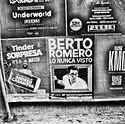Katharine Thayer
Member
- Joined
- Oct 29, 2006
- Messages
- 520
- Format
- 4x5 Format
I need to illustrate some points about print tonality in gum, and to do so I'd like to be able to express the tonal range (DMax and Dmin) of any print in a way that I can compare prints to each other, without a reflection densitometer, which I don't have and won't be acquiring.
When I was thinking about this issue several months ago, I was reading the values from the scanned file in Photoshop, and someone told me, as I recall, that you can't do this in Photoshop because Photoshop spreads the tones for any given image across the whole spectrum from black to white, so a particular value in the 0-255 histogram, or in the %brightness in HSB, or %K, wouldn't reflect the same absolute tonal value in one image as it would in another. So given that advice I abandoned that project on the spot, thinking I'd never be able to compare tonal values across prints without a densitometer.
But now I'm back to thinking about the same question again, and now that advice, as I'm remembering it, doesn't make sense to me. Yes, if you set the black and white points to the darkest and lightest values in the image, or let the scanner do that, then it would be true that the tonal values in the photoshop file would be arbitrary, would not reflect the actual tonal values in the print, and wouldn't be comparable across images. But I wouldn't do that with a scanned image; I shut off automatic settings in the scanner and let the minimum and maximum tones fall where they will on the histogram, and as far as I can see, the histogram then reflects the actual tonal range of the print.
I've been spending rather an inordinate amount of time today with a Stouffer 12-step reflection step tablet and the old two-holes-punched-in-cards-routine, to visually judge the tonal values in the print itself, and then compare those numbers to the histogram and the brightness values of the scanned print. There is a very good match between the "% reflected" values of the darkest and lightest areas in the print as taken from the step tablet and its accompanying spec sheet, and the brightness value of the HSB scale for the same areas in Photoshop, and the 0-255 values, if calculated as a percentage. So it seems to me that the Photoshop numbers do accurately reflect the actual tonal values in the print, that those values are meaningful either as % reflected (brightness) or as approximate density values from the Stouffer table, and it's a whole heck of a lot easier to let the computer do it than trying to judge the values visually. Is there something wrong with my logic; am I missing something just real obvious? If so, please tell.... thanks.
Katharine
When I was thinking about this issue several months ago, I was reading the values from the scanned file in Photoshop, and someone told me, as I recall, that you can't do this in Photoshop because Photoshop spreads the tones for any given image across the whole spectrum from black to white, so a particular value in the 0-255 histogram, or in the %brightness in HSB, or %K, wouldn't reflect the same absolute tonal value in one image as it would in another. So given that advice I abandoned that project on the spot, thinking I'd never be able to compare tonal values across prints without a densitometer.
But now I'm back to thinking about the same question again, and now that advice, as I'm remembering it, doesn't make sense to me. Yes, if you set the black and white points to the darkest and lightest values in the image, or let the scanner do that, then it would be true that the tonal values in the photoshop file would be arbitrary, would not reflect the actual tonal values in the print, and wouldn't be comparable across images. But I wouldn't do that with a scanned image; I shut off automatic settings in the scanner and let the minimum and maximum tones fall where they will on the histogram, and as far as I can see, the histogram then reflects the actual tonal range of the print.
I've been spending rather an inordinate amount of time today with a Stouffer 12-step reflection step tablet and the old two-holes-punched-in-cards-routine, to visually judge the tonal values in the print itself, and then compare those numbers to the histogram and the brightness values of the scanned print. There is a very good match between the "% reflected" values of the darkest and lightest areas in the print as taken from the step tablet and its accompanying spec sheet, and the brightness value of the HSB scale for the same areas in Photoshop, and the 0-255 values, if calculated as a percentage. So it seems to me that the Photoshop numbers do accurately reflect the actual tonal values in the print, that those values are meaningful either as % reflected (brightness) or as approximate density values from the Stouffer table, and it's a whole heck of a lot easier to let the computer do it than trying to judge the values visually. Is there something wrong with my logic; am I missing something just real obvious? If so, please tell.... thanks.
Katharine





